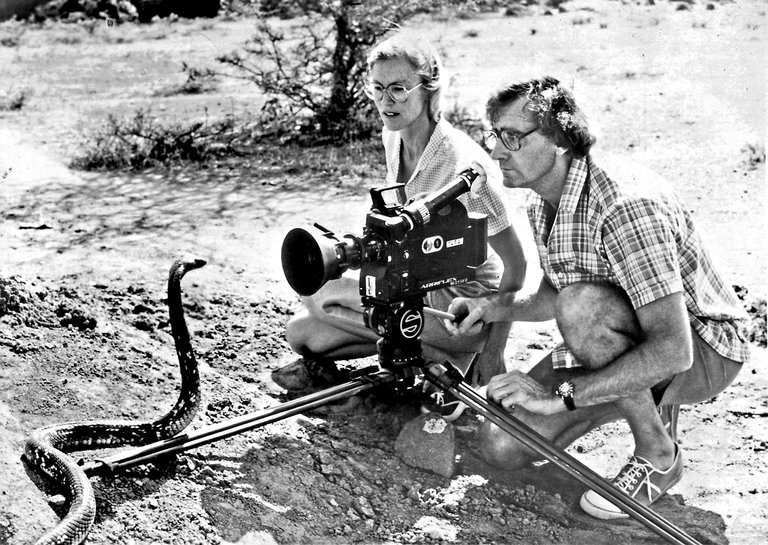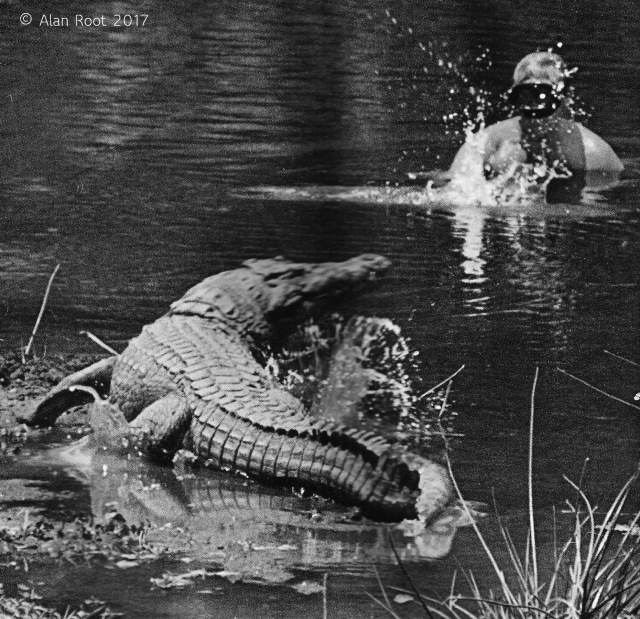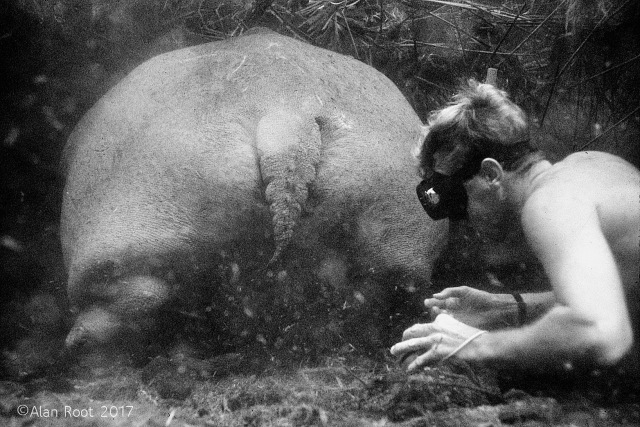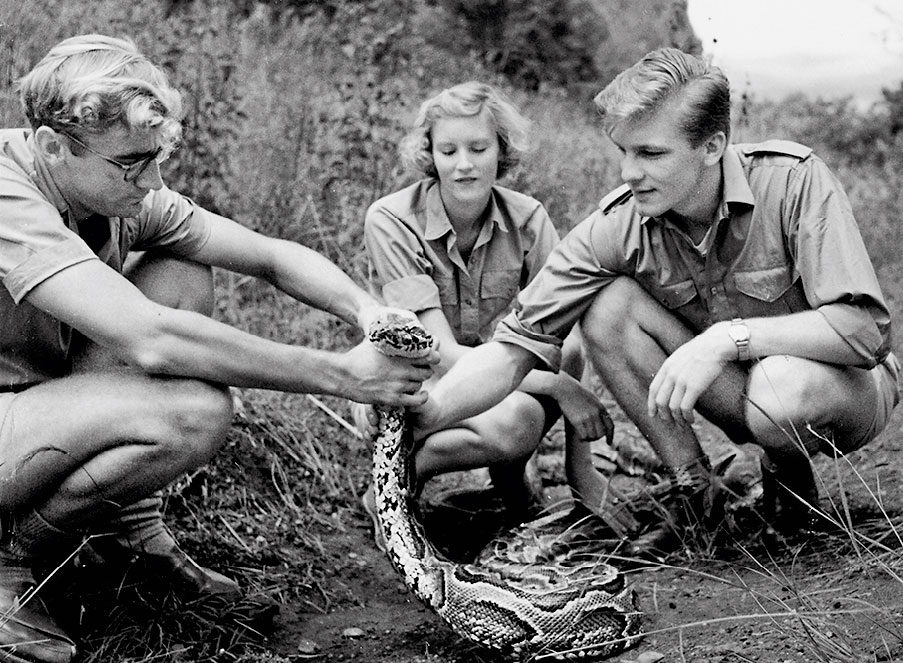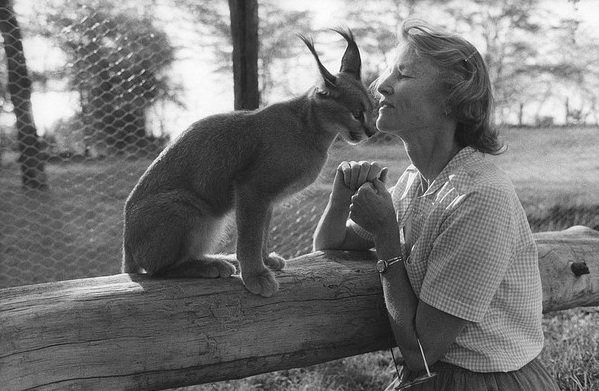Alan Root - film-maker
Consumate camerman and storyteller
Alan Root
'Alan, almost single-handedly in my opinion, made wildlife films grow up'- David Attenborough.
World renowned wildlife filmmaker Alan Root was born in London but moved to Kenya at a young age. Leaving school at 16, Alan tried his hand at numerous pursuits, learning to trap, guide and fly while launching many expeditions into the surrounding bush. Once in possession of a camera, he began to film native species and, with his natural talent obvious, he came to the attention of a visiting filmmaker, John Pearson, who hired him on the spot.
Footage from his first project, filming lily-trotters on Lake Naivasha, impressed visiting filmmakers, Armand and Michaela Denis, and Alan quickly began working for the couple, filming animals of the Serengeti for their BBC series, On Safari. 1956 saw him collaborating with the father and son team Bernhard and Michael Grzimek, on their Oscar winning film Serengeti Shall Not Die (1959), with Alan completing filming on his own after Michael’s tragic death. Alan married animal enthusiast Joan Thorpe in 1961 and the couple created a formidable filmmaking partnership, releasing an array of award-winning wildlife films over the next twenty years. Their first international success came in 1973 with Baobab: Portrait of a Tree and in 1975 they completed the first balloon ascent over Mount Kilimanjaro for their epic aerial film, Balloon Safari. Famous for their innovative cinematography techniques, the couple captured the pounding energy of a thundering wildebeest herd in their 1974 production, The Year of the Wildebeest, by placing cameras at ground level and protecting them with tortoise shells. Mysterious Castles of Clay in 1978 earned the pair an Oscar nomination and the same year a behind-the-scenes Survival Special, Two in the Bush, brought their legendary risk-taking to light. Alan has had numerous close-calls over his career and is littered with scars to prove it - having suffered hippo bites and losing a finger to a death adder. Alan and Joan separated in the 1980s and Alan went on to complete projects for various corporations including Survival, National Geographic and the BBC. In 1987, he took budding wildlife filmmakers Mark Deeble and Victoria Stone under his wing. Inviting them to the Serengeti, he helped the couple photograph and produce the critically acclaimed film Here Be Dragons (1989), which broke ITV viewing records. During his long career Alan has been honoured by over 60 awards and in 1994 received an Outstanding Achievement Award at the Wildscreen Festival.Courtesy: wildfilmhistory.org/
Alan Root died on 26 August 2017 - read the obituary here.
Joan Root
Joan Root was a Kenyan conservationist, ecological activist and Oscar-nominated filmmaker. Born in Nairobi, Root was the daughter of a British banker who immigrated to Kenya to start a new life.
With her husband, Alan Root she made a series of acclaimed wildlife films. Their movies were narrated by such distinguished actors as Orson Welles, David Niven, James Mason and Ian Holm. Their 1979 Survivaldocumentary, “Mysterious Castles of Clay”, was nominated for an Academy Award for Best Documentary. The Roots introduced Dian Fossey to the gorillas she would later die trying to save. The couple divorced in 1981 and after that Joan Root became very involved in conservation projects at and around Lake Naivasha. She chaired and funded an anti-poaching “Task Force” in the area that enforced fishing restrictions, arresting fishermen and confiscating and burning nets, in an attempt to stop overfishing.
In the last years of her life she was subjected to harassment and threats and was murdered at her home by four men carrying AK-47s. Joan Root had directed in her last will and testament that her land be turned into an admission-free and unfettered wildlife preserve.
Courtesy: livingcrueltyfree.gr/en/women-gave-lives-animal-rights/
See below for her obituary from The Telegraph in 2006.
Ivory, Apes & Peacocks by Alan Root
Written by a consummate wordsmith, Alan Root’s enthralling memoir is the best true-life adventure story to come out of Africa for years. Born in London in 1937, Root moved to Kenya while still a boy but dropped out of school at 16 and soon found himself behind a camera.
Having discovered himself to be a natural with what he calls “the grammar of film”, there followed a life you could not make up, packed with drama, humour and heartache as he followed a career of wildlife moviemaking that would bring him more than 60 awards, including three lifetime achievement awards, an Oscar and an OBE.
Filming wild animals in the African bush is not without risk, and over the years he was savaged by a variety of animals. In the Serengeti he was bitten on the backside by a leopard – only to be reproached by the warden for feeding an animal in a national park. In Rwanda, while shooting some footage for Gorillas in the Mist, a chest-beating silverback came out of the forest “like a Doberman on steroids” and took a lump out of his thigh.
On another occasion he was attacked by a hippo while filming underwater in Kenya’s Tsavo National Park. Afterwards, recovering in a Nairobi hospital, he entertained visitors by pushing a Coke bottle through the hole in his calf.
But that was nothing compared to being bitten by a puff adder. This time he was within 30 minutes of dying, but ended up losing nothing more than a finger.
In spite of these hair-raising encounters, the family home on the shores of Lake Naivasha welcomed a never-ending cavalcade of pets, including a crowned crane that fell in love with a garden standpipe, a tame hippo that regularly wandered about the Root household, and an anteater called Million (from the line in the song, “Aardvark a million miles for one of your smiles”.)
Perhaps it was Million who inspired Root to write the most succinct line ever to grace a wildlife movie commentary: “The aardvark – first word in the dictionary, last word in anteater design.”
During the Sixties, a chance meeting with the English adventurer Alan Smith (then the Telegraph’s science correspondent) led to Root pioneering balloon safaris with Richard Leakey. This episode gave rise to a whole string of tenterhook moments, as when Jackie Kennedy was a client and the balloon he was flying crashed into a cat’s cradle of telephone wires, depositing him and the former US president’s widow in a maize field.
But it was his camera work, inspired by a passion for Africa’s wildlife and wildest places, that set him apart from the rest, and his inquisitive mind came up with all kinds of extraordinary ideas to capture the scenes that would portray his subjects as never before. Hence the close-ups of thundering hooves in The Year of the Wildebeest – shot with a camera Root had hidden inside the shell of a tortoise.
The Serengeti, where he filmed the migrating wildebeest, is where he is happiest, where dust devils move across the land “like a gathering of ghosts”, and where, having spent much of his life, he still becomes wet-eyed from just knowing that such a place still exists.
It seems all the more perverse, then, to find him forsaking the Serengeti’s open plains for what he calls “the Big Broccoli” – the fathomless forests of the Congo basin that shut out the sun and hide some of the rarest creatures on the planet.
Among them is the peacock that gave Root the title for his book. After filming elephants and Africa’s greatest apes, the almost mythical Congo peacock became a grail to him, luring him into Africa’s Heart of Darkness.
It was at this time that his private life began to fall apart. He left Joan, the wife who had shared his adventures since their marriage in 1961, only to discover that Jenny Hammond, the new woman in his life, had been diagnosed with leukaemia and had only two years to live.
The final chapter, which describes Root’s last moments with Joan, I found almost too painful to read, ending as it does with her murder, gunned down alone in her Naivasha home by criminals whose racketeering was destroying the lake she loved and had fought so hard to protect. As he said at her memorial service, “She was the wind beneath my wings.”
Courtesy: Brian Jackman, The Telegraph UK
Obituary - Joan Root (from The Telegraph UK) 17 January 2006
Joan Root , who has been murdered by intruders at her home in Kenya aged 69, made, with her former husband Alan Root, some of the most adventurous and highly acclaimed wildlife documentary films to emerge from the continent.
The Roots pioneered the wildlife film that weaves a story around its subject, which varied from an animal and its habits, a tree and its inhabitants to the common termite. They produced 10 titles, mostly for Anglia Television's Survival series, some of which took up to two years to complete and involved many hair-raising encounters in the East African bush.
Their home - a farm near Naivasha in the Rift Valley, north of Nairobi - became a destination not only for people involved in the film industry but also for sundry adventurers, hunters, conservationists and pilots. Alan Root was one of the first to operate hot-air ballooning "safaris" over Kenya's game reserves, he and Joan setting another record by flying a balloon over Mount Kilimanjaro, Africa's highest peak.
She was born Joan Thorpe in Kenya in 1936, the daughter of a British settler who had come to Kenya to be a coffee planter. From her earliest years, she developed a passion for the African wild and all of its inhabitants.
It was while working as a safari guide that she met Alan Root, a Londoner who had come to the colony in search of adventure. He had been a trapper, a stunt motorcyclist and had learned to fly before picking up an 8mm film camera and discovering a career as a cinematographer. Root found Joan "painfully shy", but when he heard she had successfully hand-raised an orphaned baby elephant he decided she was worth pursuing.
As he pithily put it later: "Before we were married she wore a monocle and so did I. Together we made quite a spectacle." In fact, Joan, quietly-spoken and self-effacing, made a perfect counterpoint to the ebullient and daredevil Root. Her modesty disguised a will of iron and raw courage - much needed in the frequently hazardous work they were undertaking.
She had a bitter taste of what her married life might hold on her honeymoon night. The couple were camped near the Tsavo River Bridge in eastern Kenya, listening to the roars of the lions which might have been descendants of the notorious man-eating cats that terrorised the area nearly a century before. They survived the lions but romance disappeared rapidly from their tent when Joan was stung by a scorpion.
The Roots' first successful film was Baobab: Portrait of a Tree, which took nearly two years to make as they caught on film the seasonal changes of growth and the myriad creatures that live in and off these trees. There followed Mysterious Castles of Clay, in which they spent months, day and night, filming termites building one of the towering mounds which dot the African savannah, only to have it destroyed in a matter of hours by an aardvaark.
Joan Root knew she could never curb her husband's risk-taking in the making of a film or in his flying or balloooning. "I just made sure I was there with, hopefully, the right medication or words of comfort until we could get him to hospital," she once said. Unlike Alan, Joan never readily put herself in the path of danger; but accidents did happen.
When the couple were filming hippos underwater for Mzima: Portrait of a Spring, Joan had the face mask of her diving suit bitten off by an angry male hippo. Inches further and she would have lost her head to a pair of massive jaws; Alan was bitten in the leg by the same beast, and nearly lost it.
When Alan decided between films to set a ballooning record by flying over the 19,340-feet high peak of Mount Kilimanjaro he belatedly had Joan join him, hauling her into the basket as the balloon lifted off. They were in thick cloud for the first half an hour as the balloon ascended. At one point the flame on the vessel's burner blew out, and Alan fumbled with the matches to relight it.
As they broke into the sunlight, Joan became uncharacteristically snappy and clumsy. This puzzled Alan until he noticed that the tube from her oxygen supply had become snagged. A rapid repair job soon had Joan back to her normal, placid self, and the couple marvelled as they cruised at 24,000 feet over Kilimanjaro. They made a gentle descent and landed in Tanzania, then in hostile relations with neighbouring Kenya. Their celebrations were muted when they were arrested by the Tanzanian authorities and held briefly as "astronaut spies".
The film, which the Roots regarded as their own favourite, concerned the mass migration of wildebeest through Tanzania. The Year of the Wildebeest won international acclaim and many awards, although Alan, with his Cockney humour to the fore, referred to the project as "Brave Gnu World". During one shooting session in the Serengeti, he was bitten on the backside by a startled leopard. Joan, as always, was on hand to treat the wound until they could get her husband to Nairobi hospital, where he was regarded as a "regular".
In the making of Two in the Bush, Joan and Alan were themselves filmed to show how they went about their adventurous life. At one point in the film, Alan insisted that Joan be the target of a captured spitting cobra, a compelling scene in which her spectacles were quickly coated with deadly poisonous venom. The film was widely criticised as being too self-indulgent. The Roots agreed. "It was more of a home movie," said Alan.
Nairobi and the documentary film world were shocked when Joan and Alan Root were divorced in the mid-1980s. "It was very saddening news. They had made such a name for themselves as a couple and it seemed an ideal partnership in every way," said one of their executive producers.
The parting was amicable, and Joan stayed on at their Naivasha farm, throwing herself into conservation work. She campaigned vigorously to prevent the growing wave of human encroachment from spoiling the wildlife in, on and around Lake Naivasha.
Her anti-poaching activities made her some enemies within the African communities around the lake and may have played a part in her death.
Joan Root died on January 12 2006. The couple had no children.
ARTICLES OF INTEREST
Two in the Bush - an ITV Survival documentary (uTube)
The Year of The Wildebeeste (Alan Root Documentary ITV Survival)(uTube)
Interview with Joan and Alan Root (uTube video) circa 1980
The Murder of Joan Root, and the Cause That Killed Her (uTube)
Alan Root - a link to several videos (uTube)
